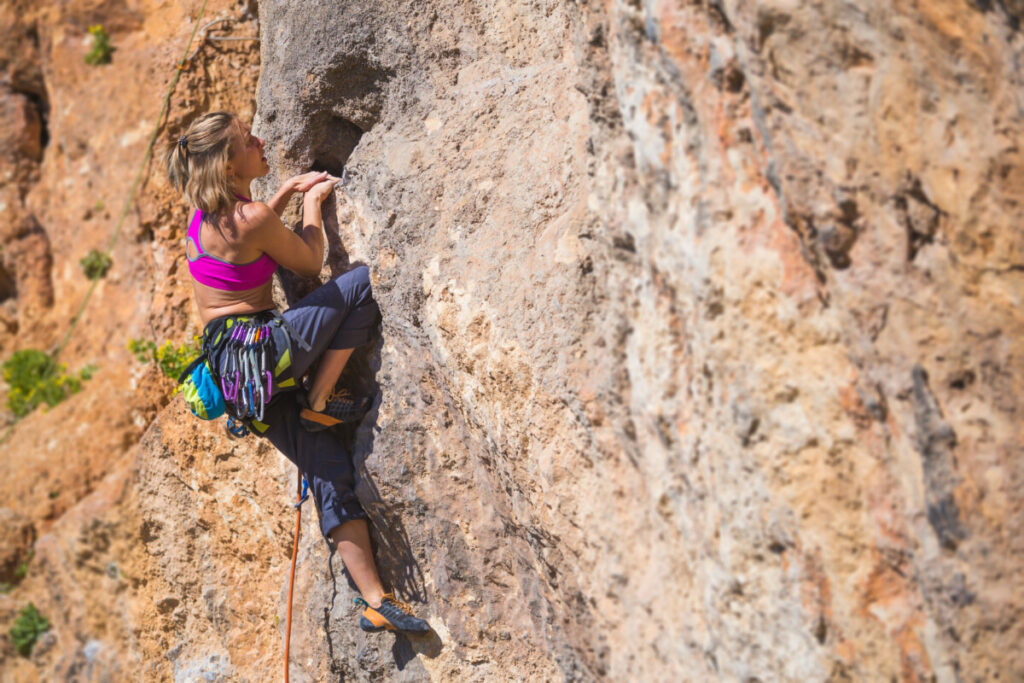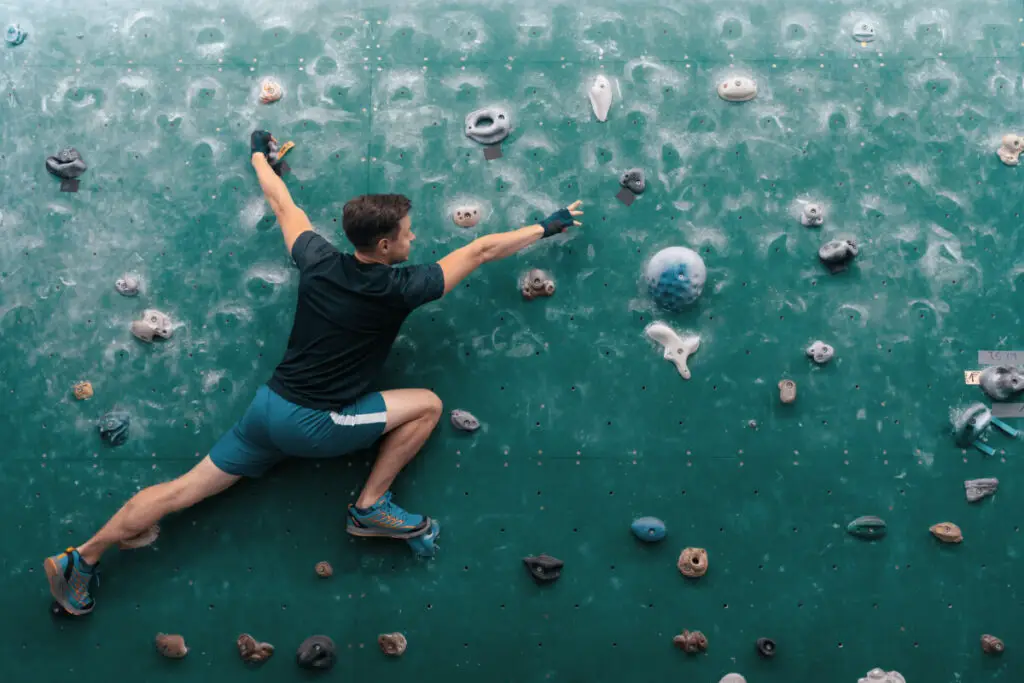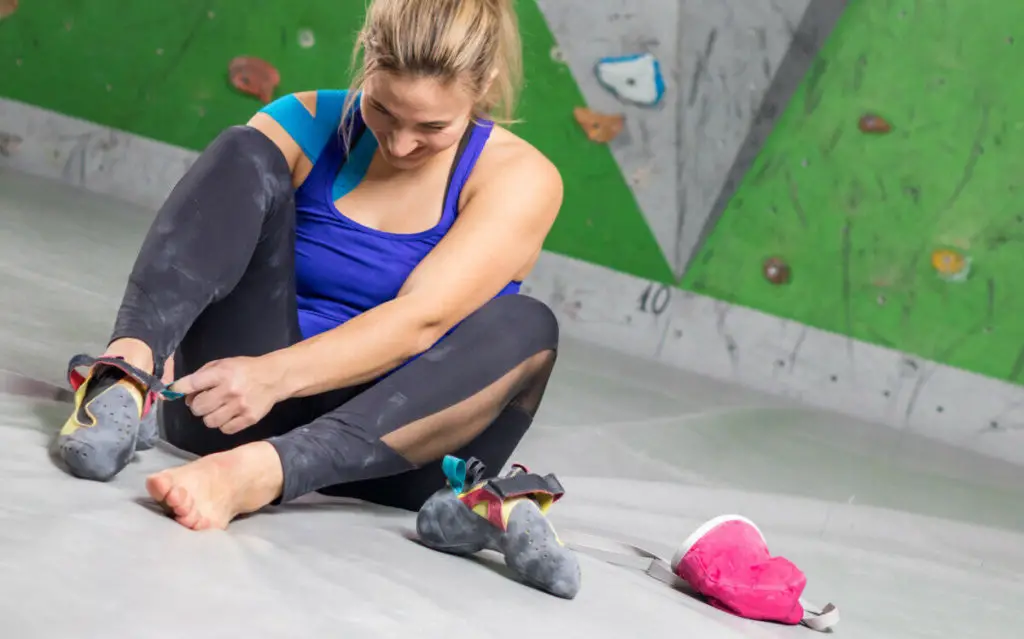
Climbers can choose from a wide variety of different methods to get up a mountain, rock wall, or even boulder. The styles of climbing all include the base concept of using your hands and feet to latch onto rocks or platforms to ascend the mountain. What differentiates climbing styles has to do with equipment, strength style, and techniques, making them separate and sometimes not very comparable.
Bouldering is harder than rock climbing. Since there is little equipment, bouldering has greater risks and no resting position which requires more focus and energy. Although, the two are very different, and determining which one is harder depends on the type of strength one obtains.
Based on the type of climber you are, bouldering might be harder to figure out than rock climbing. On the other hand, it’s still a great option for beginner climbers and requires different skills because of these reasons.
Why Is Bouldering Harder Than Rock Climbing?
When it comes to bouldering vs. rock climbing, it’s a personal preference of which one is better. Think about it compared to skiing and snowboarding. Not only do most people gravitate towards one or the other, but often certain people will find each one to be easier or more difficult for them to get a hang of.
Typically, bouldering is more difficult than rock climbing. It is known as one of the most technically oriented climbing styles and contains a lot of powerful move discipline. Bouldering requires a lot of strength because you are pulling your entire body up the wall. This strength must be reliable because no ropes or belayers are spotting you if you need to rest or end up slipping.
This makes it difficult for some people because although there are fewer moves, there’s more risk. Since there’s no harness, climbers must think thoroughly before making any move, which takes a lot of concentration. You have to be focused and strong enough to hold your weight while you’re thinking of where to go. (Source)
Bouldering consists of a lot more problem-solving skills and techniques than rock climbing. This activity is known as a challenge that uses legs, arms, forearms, and finger strength. As you scale up the boulder, you are making short but powerful moves. These moves are getting you to the next handhold until you’re at the top, so you must be able to control that strength and move strategically. (Source)
Some common techniques in bouldering:
| Flagging | Placing your foot to either the inside or outside of your other foot to adjust where your center of balance is, enabling you to reach the next hold. |
| Drop Knee | This is placing your foot on a foothold, which is about the height of your hip, then using the foothold with a lunge-like movement to get higher in the route. |
| Smearing | Pressing against the wall if there is not a foothold where needed. |
| Straight Arms | Used when climbing inverted routes to help keep as much strength in the arms as possible while climbing horizontally, and your back is facing the ground. |
| Reading the route/beta | Before you get on the route, you recognize which moves are needed to make so your energy can be put into making the moves and not thinking about them. |
Which Strength Styles will Help You with Bouldering or Rock Climbing?
What’s mainly going to determine if bouldering or rock climbing is easier for you is your strength because depending on the rock you’re climbing, most people argue these two styles are not comparable.
Since bouldering usually contains shorter rocks than rock climbing, it needs different strengths. Bouldering is better for climbers who might have less endurance, but a strong, quick release and explosive strength.
If one has more enduring muscles, then they might be more successful at rock climbing and prefer this technique. Rock climbing takes longer, but there isn’t nearly as much risk. (Source)
Is Bouldering Hard For Beginners?

Bouldering is hard in general, even for avid climbers, so it will be difficult for those who are starting to dabble in climbing. The routes can also be challenging, including some beginner routes. It can also be more physically demanding for beginners who haven’t yet refined climbing-specific muscles. However, bouldering is a great way for new climbers to experience the sport with little to no cost.
It’s very accessible for new or advanced climbers to participate because there’s very little equipment needed. It’s easy for almost anyone to go out and boulder as long as you have climbing shoes, a chalk bag, a crash pad, and an experienced spotter if you are a beginner. (Source)
Unlike rock climbing, you don’t need ropes and a harness to scale up the rock while bouldering. Without having to understand how bouldering works, you really just have to figure out the moves. Interestingly enough, a lot of beginners usually find rock climbing or rope climbing to be harder than bouldering because of the height difference and endurance. Rock climbing also tends to be easier on the joints, so it’s more simple for older people to pick up.
Essentially, bouldering can be as hard or easy as you make it for a beginner climber. If you find the right rock, it could be pleasant. Especially if you live near the mountains, then locating a spot outdoors saves you the price of visiting a climbing gym. A large portion of people have climbed rocks outside whether it was large or small, but that’s considered bouldering.
How Long Does it Take to Get Good at Bouldering?
Based on how often you climb, you’re bound to see your technical skills start to persistently improve if you are bouldering at least 2 to 3 times weekly. It’s more difficult to move up from grade V4 or V5 to V6 or V7, so that will need climbing more often and sometimes training at home to keep muscle memory. (Source)
It can take up to five years to reach V7 with consistent training. But, getting to V4 to V5 from V1 is a lot faster to achieve and is possible within the first few months. Above a V7 is very hard and most people never reach it. The people who get to V10 commit a full decade of bouldering to do it.
Beginner Tips & Etiquette for Bouldering
Here are some tips to keep in mind when you start bouldering.
- Share the wall: If you’re the only one at the boulder, you don’t need to worry about making room and you can use up the whole wall as you please. When there are more people, you must get out of the way once you’ve fallen. It’s common etiquette to take turns, so if you see your climb overlaps someone else’s, don’t go until the other climbers are clear.
- Make friends: Bouldering is one of the most social types of climbing, so don’t be shy about getting to know people and you can make a lot of friends.
- Keep track of your belongings: If you’re at a climbing gym, make sure you don’t leave your water bottle on the pads. If you’re climbing outside, don’t spread your whole kit out right under the boulder. You should also leave the area the way you found it whether you’re inside or outside.
- Communicate with other climbers: Keep communication present when it’s appropriate and needed. For example, if you’re at a gym with moveable pads, ask the climbers close by before you move them around. Before you try a move with wild swings or falls, you might want to warn any nearby climbers so there isn’t an accident.
- Brush off chalk markings: After you make any tick marks for handholds or footholds, brush them off so that the next climbers can figure it out for themselves.
- Feel free to ask questions: Boulderers are generally welcoming and are happy to help anyone learn, so feel comfortable asking people questions.
- Be cautious when it comes to noise: If you’re at the gym wearing headphones, you should make sure that the volume isn’t too loud so you can still hear other climbers if they are warning you. The same goes for outside, be cautious of your surroundings before you play music super loud on a speaker or through your headphones. (Source)
Does Bouldering Help With Rock Climbing?

Bouldering does help train a climber to be better at rock climbing in some ways. For example, it helps them master more technical moves that need more control, balance, and precise footwork. These help you rock climb higher walls because you can focus on other things like endurance.
Since bouldering is very centered around technique, this understanding is very helpful. If someone is mainly bouldering, then they will have success with the technical aspects of rock climbing. It goes both ways though, where if you are strictly rock climbing, you will exceed at endurance and energy aspects of bouldering.
Types of rock climbing:
- Top Rope Climbing: This is the most common type of rock climbing that is learned, probably because it’s the easiest and least dangerous one. With top rope climbing, the climber is tied to a rope that is fastened to an anchor point at the top of the rock. This rope goes back down to whoever is on the ground and is there if the climber falls. The rope is always above because it lessens the chance of getting severely hurt if one falls.
- Lead Climbing: Often people say that this type of rock climbing is a mental commitment because your rope is tied to your harness and lingers along as you climb. The opposite end of the rope is fed to a belay device so that if you fall, the belayer can slow or stop the fall. There is potential to have a serious fall when lead climbing.
- Indoor Climbing: This style is also very popular, and is basically top roping but indoors. You are able to have a very safe and controlled environment since most indoor climbing is available at most bouldering and climbing gyms. Usually, you can rent the equipment there, take lessons, socialize with other climbers, and you can learn the essentials needed for outdoor climbing. (Source)
Pros and Cons to Bouldering and Rock Climbing
Bouldering Pros:
- Requires very little equipment, making it more accessible and affordable.
- The majority of your body’s muscles are being exercised when bouldering, along with brain muscles. It takes a lot of focus and problem-solving.
- It’s a very social form of climbing.
- Can be done indoors and outdoors.
- It’s a fun and exciting form of exercise.
Rock Climbing Pros:
- When you fall or slip, the rope catches you and it’s fairly safe.
- If you fall, you can pick up right where you left off climbing.
- Rock climbing improves your cardio-respiratory wellness, heart rate, stamina, and muscular endurance.
- Develops lean muscle throughout the body, and you’re working out so many different parts of your body.
- It helps improve balance.
- Can help you overcome a fear of heights, and you can see some great views climbing up high.
Bouldering Cons:
- When you fall, you have to start all over again.
- If you fall, you hit the ground, which can result in serious injuries.
- You can’t really take any breaks to figure out/test different ways to go about the route. There are also no rests available because you aren’t harnessed.
- There is a lot of physical and mental stress while bouldering because you have to problem solve quickly and there’s the fear of falling sitting in the back of your mind.
- It’s a sport that’s very hard to master.
Rock Climbing Cons:
- Requires a lot of endurance and one has to be physically strong to get all the way to the top.
- More equipment is needed to rock climb.
- Although it’s safer, strains can be caused by overuse and most often these occur in the arms, wrists, shoulder, and fingers.
- It can be an expensive sport.
- There is a risk that something bad happens and the equipment isn’t sturdy, accidents, or in regards to outdoor weather.
- Is time-consuming, and takes more time to get situated since you have to set up ropes, belays, etc.

